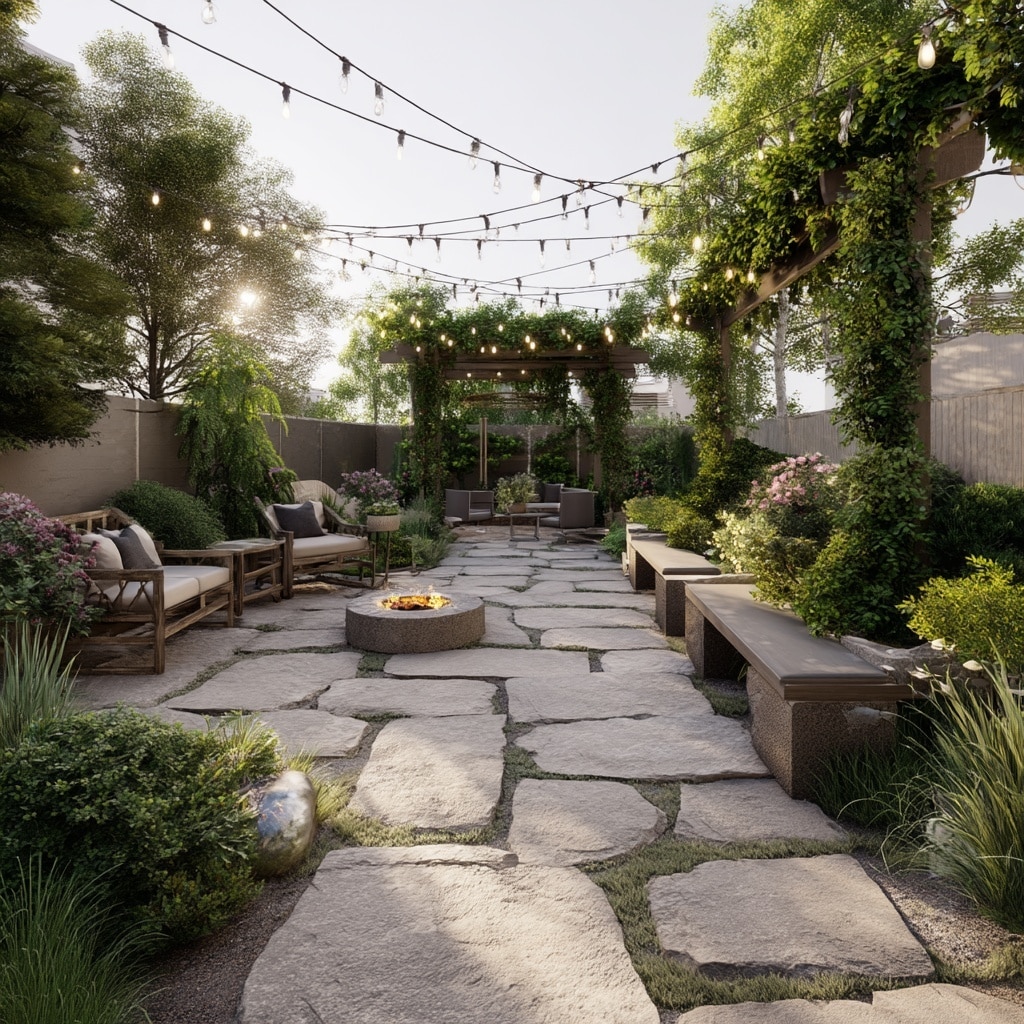Backyard landscaping is more than just planting flowers—it’s about creating a personal oasis where you can relax, entertain, and enjoy the beauty of the outdoors. Whether you have a spacious suburban yard or a compact city space, thoughtful design can turn even the smallest areas into functional and beautiful retreats. With the right planning and a few creative touches, backyard landscaping ideas for small yards can deliver just as much charm and functionality as larger spaces. In this guide, you’ll find practical tips, inspiration, and expert advice to help you transform your backyard into a place you’ll love spending time in—no matter its size.
Table of Contents
Planning Your Backyard Living Space
Effective backyard landscaping starts with a solid plan. Before breaking ground, take time to evaluate the space and determine how you want it to function. This thoughtful approach ensures your outdoor area will be both practical and enjoyable year-round.
Assess Your Space
Start by measuring the dimensions of your backyard. Is it flat or sloped? Are there existing trees or shrubs you want to keep or remove? Observe how sunlight moves across the space throughout the day—this will guide your decisions on plant placement, seating areas, and shade structures.
Define How You’ll Use the Space
Think about your lifestyle and how you’d like to use your backyard:
- Do you want a cozy nook for morning coffee?
- A safe play area for kids or pets?
- A spot for weekend barbecues or evening dinners?
- A peaceful corner for reading or meditation?
You don’t need a large yard to fit in multiple uses—just smart zoning.
Consider Privacy Needs
Privacy is one of the most common reasons for a backyard redesign. Fencing, hedges, or decorative screens can shield your space from nosy neighbors or busy streets. For smaller yards, consider vertical plantings or trellises with vines—they offer greenery and seclusion without taking up much space.
Create “Outdoor Rooms”
Just like inside your home, different backyard zones can serve different purposes. Use walkways, potted plants, pergolas, or lattice dividers to separate areas. For example:
- A dining patio near the kitchen
- A fire pit lounge area
- A raised garden bed tucked into a sunny corner
Creating these distinct “rooms” makes your yard feel larger and more organized.
Stay in Scale
For compact spaces, avoid oversized furniture or structures. Instead of a full dining set, opt for a small bistro table. Choose compact plants or dwarf trees that won’t overwhelm the space as they mature. The key to successful backyard landscaping—especially in smaller yards—is finding the balance between comfort and proportion.
Draft a Simple Sketch
Even a rough drawing helps visualize your plan. Mark out zones, pathways, and where you’ll place major elements like seating or raised beds. If your vision is complex, consider consulting a landscape designer—but many homeowners find DIY sketches helpful and cost-effective.
Set a Budget and Timeline
Costs can vary widely depending on the scope. Decide what you can afford now and what can be added later. Sometimes a phased approach—doing hardscaping first, then planting—helps spread out expenses without compromising the final look.
Planting and Caring for Your Backyard Landscape
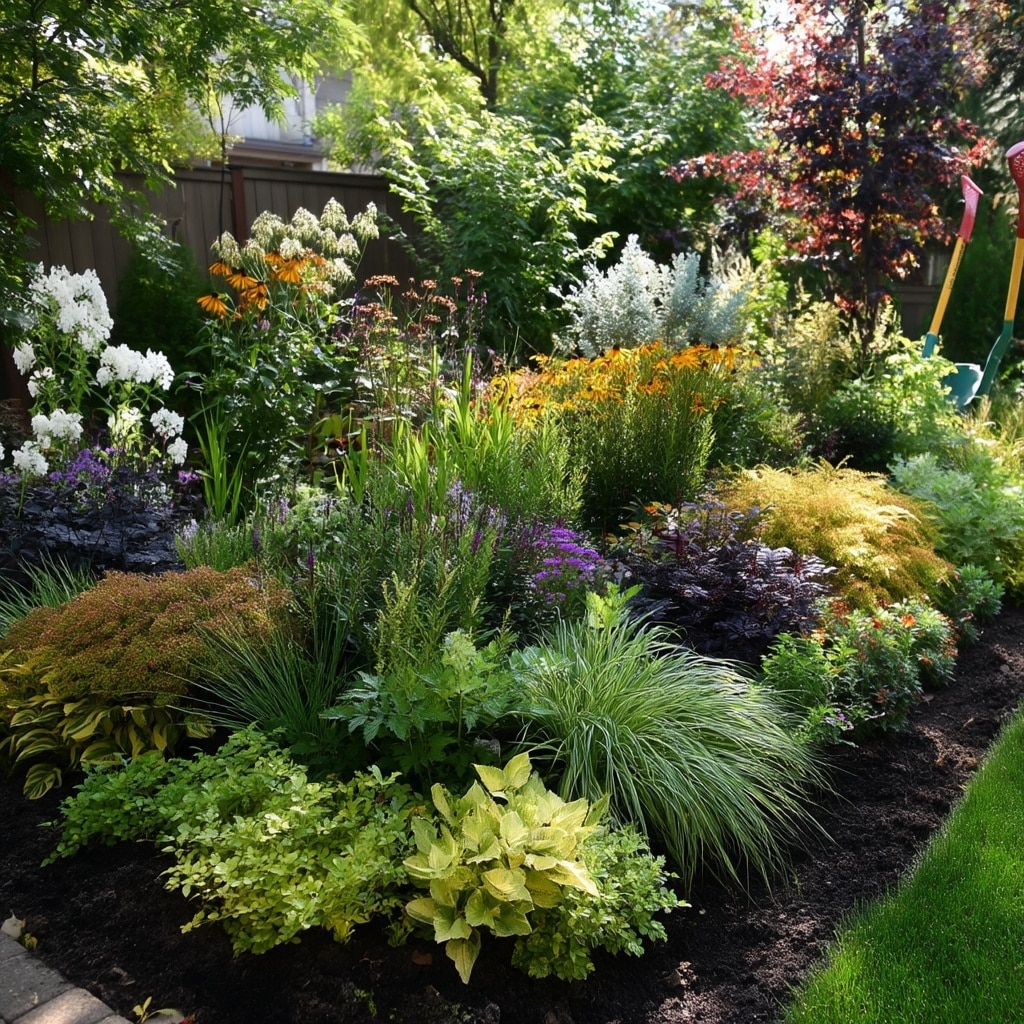
A well-planned planting scheme is the heart of any great backyard landscaping project. Choosing the right plants and giving them the care they need not only boosts curb appeal but also ensures your outdoor space thrives with minimal effort.
Test and Improve Your Soil
Before planting, take time to test your soil. Many backyards—especially those with turf or compacted areas—lack nutrients and proper drainage. Use a soil test kit to check pH levels and nutrient content. Based on the results, amend the soil with compost, aged manure, or organic matter to create a fertile base for plant growth.
Choose the Right Plants for Your Conditions
Match plants to your backyard’s light, soil, and moisture levels. Observe which parts of your yard get full sun, partial shade, or remain damp after rain. For small spaces, choose plants that offer multiple seasons of interest—like blooms in spring, colorful foliage in fall, and structural appeal in winter.
Here are some plant selection tips:
- Trees & Shrubs: Use for structure, shade, and privacy
- Perennials: Provide year-after-year color
- Annuals: Great for seasonal accents in pots and beds
- Groundcovers: Fill in gaps and reduce weeds
- Native Plants: Support pollinators and require less maintenance
Layer Your Plantings
A layered look creates depth and visual interest. Place taller plants or shrubs at the back or center (depending on your layout), medium-height perennials in the middle, and groundcovers or low plants in front. This approach works especially well in backyard landscaping ideas for small yards, helping the space feel fuller without clutter.
Design for Seasonal Interest
To avoid a backyard that looks barren in winter or too busy in summer, mix plant types that peak at different times. Aim for a mix of textures, colors, and shapes across all four seasons. Evergreens, ornamental grasses, and plants with colorful bark or berries are great for year-round appeal.
Plan for Maintenance Needs
Be honest about how much time and energy you’re willing to spend on upkeep. Drought-tolerant plants, native species, and mulch beds reduce watering and weeding. If you love gardening, go for a mix of vegetables and flowers. If you want a low-maintenance retreat, focus on durable plants and hardscaping features instead.
Design Considerations for a Functional Backyard
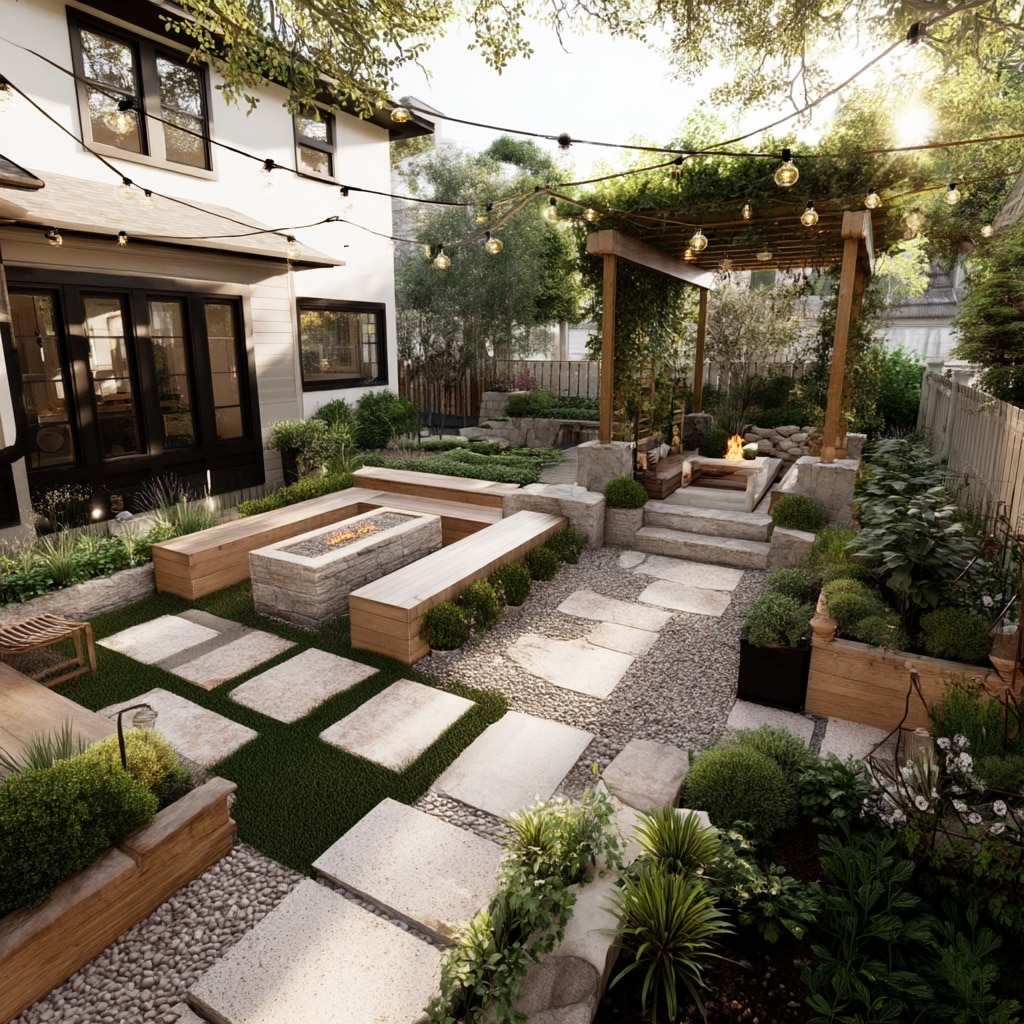
Thoughtful design goes beyond looks—backyard landscaping should also support how you move through and use your space. From walkways to seating, each element should work together for comfort, safety, and flow.
Create Smooth Traffic Flow
Make sure pathways are wide enough for easy movement. Ideally, paths should be at least 36 inches wide, and seating areas should have enough space around chairs or benches for people to move freely. Connecting “rooms” in your yard with subtle transitions—like stepping stones, gravel paths, or arbors—enhances both functionality and beauty.
Place High-Use Areas Strategically
Keep grilling and dining areas near the kitchen door for convenience. Relaxation zones—like hammocks or reading corners—can be set farther from the house for more peace and quiet. Thoughtful placement ensures you’ll use each zone regularly, especially in backyard landscaping ideas for small yards, where efficiency is key.
Invest in Durable Materials
Spending a little more on long-lasting materials—like metal furniture, composite decking, or concrete pavers—pays off over time. Cheap items often need replacing sooner and may not withstand weather changes. Look for outdoor-rated items that can endure sun, rain, and temperature swings.
Layer and Vary Your Plantings
Design with depth in mind. Combine trees, shrubs, perennials, and groundcovers of various shapes and heights to soften hard edges and create a lush feel. This layering also provides privacy, visual interest, and a welcoming habitat for birds and pollinators.
Think Vertically
Especially in smaller backyards, vertical space is valuable. Use trellises, garden walls, or hanging baskets to add greenery without using up ground space. Vining plants like clematis or honeysuckle offer beauty and coverage without overwhelming tight areas.
Add Lighting for Evening Use
Extend your enjoyment into the evening by incorporating lighting:
- Path lights for safety
- String lights or lanterns for ambiance
- Uplighting to highlight trees or art features
- Solar-powered options for energy efficiency
Good lighting makes your backyard safer and more inviting after dark.
Use Containers for Flexibility
Planters and pots are ideal for changing up your design through the seasons. Use them to:
- Define boundaries
- Add pops of color
- Fill hard-to-plant areas like decks or patios
In backyard landscaping, containers also help small yards look lush without permanent installations.
Prioritize Safety
A beautiful yard should also be secure and accessible:
- Keep walkways level and slip-resistant
- Avoid sharp edges on furniture or structures
- Install lighting along steps or elevation changes
- Ensure seating areas have stable surfaces beneath
Add Finishing Touches
Personal elements make a backyard feel complete. Consider:
- Outdoor art or sculpture
- Fountains or water features
- Fire pits or chimineas
- Wind chimes or rain chains
These details give your yard a custom feel and reflect your personality.
Backyard Landscaping Ideas & Inspiration
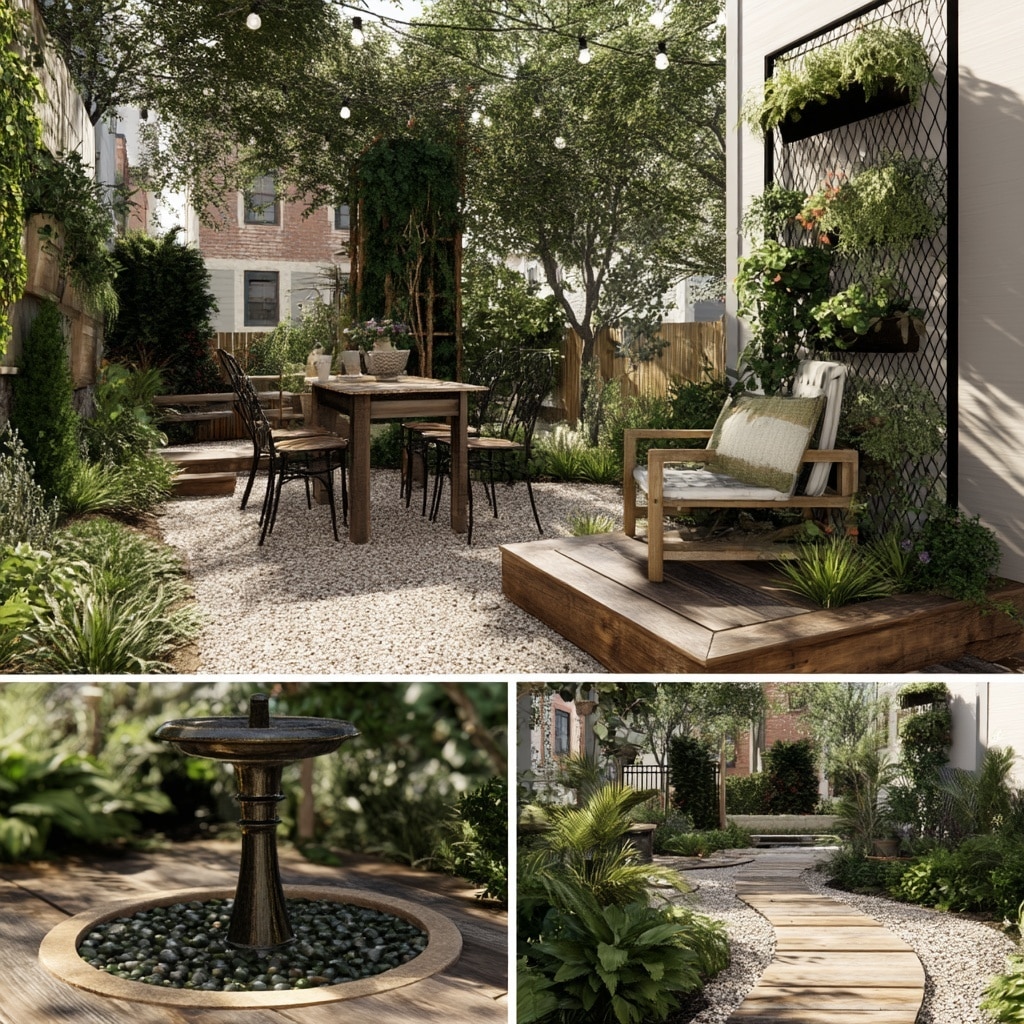
Whether your outdoor space is big or small, there’s no shortage of creative ways to bring it to life. These backyard landscaping ideas showcase the variety of styles, features, and layouts that can make your yard more enjoyable—and uniquely yours.
Design with Purpose
Incorporating “rooms” within your backyard helps you get more out of every square foot. Consider dedicating areas to:
- Outdoor dining: A patio with a dining set and string lights
- Relaxation: A cozy seating nook under a pergola
- Gardening: Raised beds or vertical planters for flowers and herbs
- Entertaining: A fire pit surrounded by weatherproof chairs
In smaller yards, multifunctional spaces are key. A bench with storage, or a planter box that doubles as a privacy screen, can save space while adding style.
Incorporate Water and Fire Elements
Water features and fire pits add both ambiance and function. A compact fountain can mask city noise, while a fire pit extends the use of your yard into cooler months. In tight spaces, tabletop versions of these features work well without overwhelming the layout.
- Water feature ideas: Birdbaths, tabletop fountains, narrow ponds
- Fire feature ideas: Portable fire bowls, chimineas, built-in stone pits
These elements bring movement, warmth, and atmosphere—enhancing both large and small backyard landscaping efforts.
Mix Materials for Texture
Combining different materials—like gravel, flagstone, wood, and greenery—adds richness to your design. For example:
- A stone pathway lined with groundcover
- A wood deck with container gardens
- A gravel sitting area with sculptural plants and boulders
This mix of hardscape and softscape helps break up the space visually, especially in smaller yards where texture adds depth.
Include Eco-Friendly Features
Sustainable design is a growing trend in backyard landscaping. Try:
- Permeable pavers to reduce runoff
- Drought-tolerant plants for water conservation
- Rain barrels to collect water for irrigation
- Green roofs on sheds or garden structures
These features benefit the environment and often reduce long-term maintenance and utility costs.
Add Personality with Art and Decor
Personal touches can turn an average yard into a standout space. Think about:
- Mosaic stepping stones
- Custom garden signs
- Hanging planters painted in bold colors
- Local or handmade sculptures
Even a small yard can feel like a creative retreat with the right accents.
Make Use of Every Corner
Don’t overlook narrow strips, awkward corners, or fence lines. These are great places for:
- Vertical gardens
- Trellised vines
- Corner seating
- Tall planters
Maximizing these areas is especially important when applying backyard landscaping ideas for small yards, where no space should go to waste.
Popular Backyard Profiles & Real-Life Examples
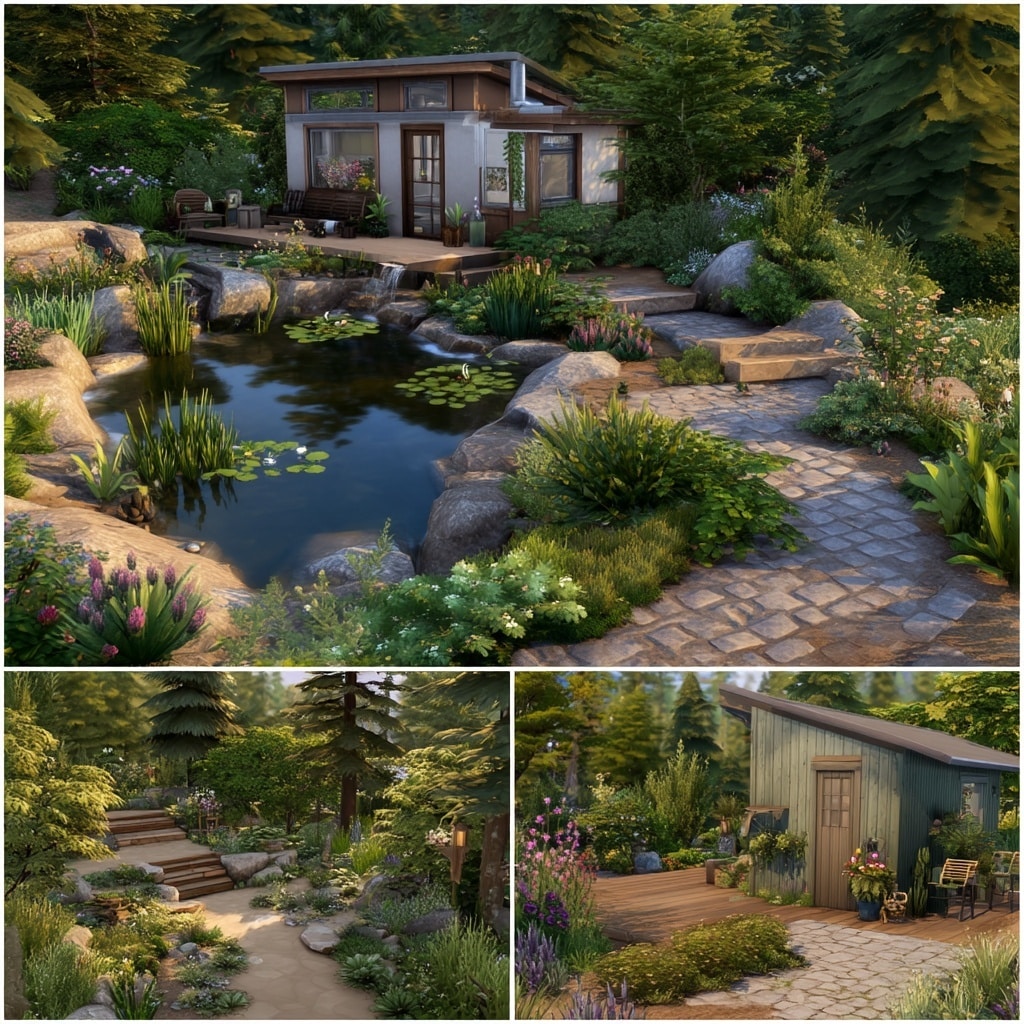
Sometimes the best backyard landscaping ideas come from seeing what other homeowners have done with their own outdoor spaces. These real-life examples show how creativity, thoughtful planning, and even modest budgets can lead to stunning results—especially in small or challenging yards.
A Pond-Centered Wildlife Haven
In Delaware, one couple designed their entire backyard around a serene pond. Surrounded by native plantings, the pond attracts birds, frogs, and butterflies. A screened porch and stone patio overlook the water, creating a peaceful escape that feels far from suburban life.
Takeaway: If you love nature, even a small water feature can draw wildlife and provide a calming focal point.
Urban Garden Rooms
A city homeowner transformed a narrow backyard into a series of functional “rooms.” The space includes a shaded sitting area with a canopy, a small herb garden, and a gravel pathway connecting the sections. Vertical plantings provide privacy without closing off light or airflow.
Takeaway: Dividing small yards into zones creates the illusion of more space and supports multiple uses.
Sloped Backyard Turned Sanctuary
One homeowner dealt with a challenging slope by installing tiered garden beds, retaining walls, and layered plantings. The design includes a tucked-away fire pit and a small waterfall that masks nearby traffic noise.
Takeaway: Uneven terrain isn’t a barrier—it’s an opportunity to add depth and dimension.
Eco-Friendly City Retreat
In a compact urban lot, a designer used permeable pavers, drought-tolerant plants, and a green-roofed garden shed to create a low-maintenance backyard. A gravel patio with recycled wood furniture completed the sustainable setup.
Takeaway: Eco-conscious backyard landscaping choices are beautiful, functional, and environmentally smart.
Lounge Area with a Fireplace
One long, narrow yard was turned into an inviting lounge with a plush sectional sofa and stone fireplace. Tall planters added semi-privacy, while lighting extended usability into the evening.
Takeaway: Prioritizing comfort and ambiance can make your backyard feel like an outdoor living room.
She-Shed Retreat
In a backyard corner, a small shed was transformed into a personal getaway filled with comfy chairs, houseplants, and artwork. Surrounded by potted flowers and vines, it feels like a garden cottage.
Takeaway: Repurpose small structures for solo time, hobbies, or creative pursuits.
Conclusion
Smart backyard landscaping can completely transform your outdoor space, no matter its size. By planning carefully, choosing the right plants, and incorporating thoughtful features like seating, lighting, and privacy elements, you can turn any backyard into a personal retreat. Whether you’re working with a small city lot or a larger suburban yard, the right design choices make all the difference. Use these ideas and examples as inspiration to create a space that feels like a true extension of your home—beautiful, functional, and uniquely yours.

